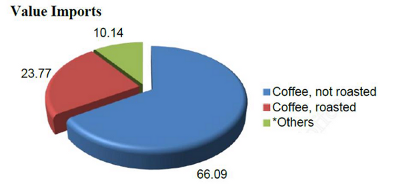- Shortly after the 30th anniversary of the economic reforms led by Deng Xiao Ping, China has emerged as one the world’s major economies.
By the end of 2009, China’s GDP surpassed that of Germany, becoming the world’s third largest economy just behind the USA and Japan, and by 2050 it is expected to outpace the American one.
Coffee demand in China has substantially increased, although volumes are still low in relation to forecasts. Even if it is still seen as a tea nation, like England, China is expected to become one of the world’s largest coffee importers. It currently imports the bean from Brazil, Colombia, Kenya, and Vietnam, among others.
The coffee market in China, driven by consumption in large coastal cities, doubled between 2001 and 2006, and a 7.8% growth is expected for 2011-2016, according to Euromonitor.
Figure 1. Forecast coffee growth in China (2011–2016)

Latte is becoming popular among young consumers, and there is a moderate shift in preferences from soluble to freshly roasted coffee, as shown below in terms of value of imports by product type.
Figure 2. Value of imports by coffee type in 2009 (USD ’000)

Growing income, improved living conditions, urbanization, and adoption of Western habits by young people, as well as lifted restrictions for retailing are some reasons behind China’s market growth.
A number of new coffee shops have opened in the country (not only of large chains such as Starbucks, which arrived in 1998 and now has over 450 shops), but also smaller ones such as Horst Coffee, a current member of the 100% Colombian coffee program.
And there are increasingly more Chinese baristas interested in high-quality coffee. Aware of this, in 2011 the FNC started offering courses to Chinese cuppers in Colombia for forging close and lasting relationships with local industry players and positioning Café de Colombia as a widely recognized origin in this growing market.


